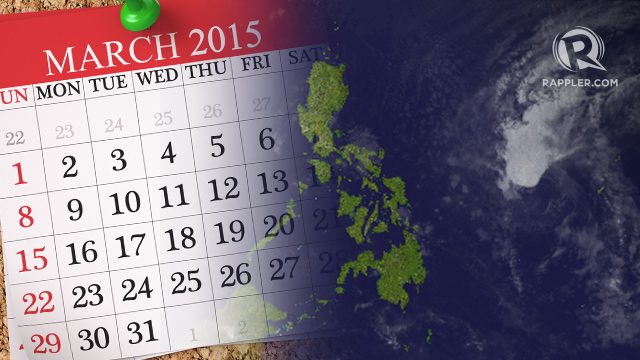SUMMARY
This is AI generated summarization, which may have errors. For context, always refer to the full article.

MANILA, Philippines (UPDATED) – Storms in the Philippines in the month of March is uncommon, but still possible.
In 2015, Tropical Storm Betty (international name Bavi) entered the Philippine Area of Responsibility (PAR) Tuesday evening, March 17.
Packing maximum sustained winds of 65 km/h near the center when it entered PAR, Betty weakened into a tropical depression and was later downgraded into a low-pressure area until it dissipated.
Betty is only the 20th storm since 1948, and the 8th in the last 15 years, to enter PAR in March, according to data from PAGASA. The first occurrence was in 1954.
As of 2015, March ties with February as the months with the least number of tropical cyclones entering PAR, with 20. Next are the months of April (with 33 storms) and January (with 32).
Eleven storms in March made landfall, with the last 3 being Tropical Depression Caloy in 2014, Tropical Storm Auring in 2005, and Tropical Depression Caloy in 2002.
Among them, 7 storms, with 2 classified as typhoons, have caused considerable to heavy damage in the country:
1. Typhoon Bebeng (Sally), March 2 to 5, 1967
– maximum wind speed of 120 km/h recorded in Surigao and 180 km/h over water
– 1 dead, with considerable damage to property
2. Tropical Storm Biring, March 20 to 24, 1980
– maximum wind speed of 85 km/h recorded in Daet
– 4 dead; P3.1 million in damage
3. Tropical Storm Akang (Mamie), March 18 to 22, 1982
– maximum wind speed of 95 km/h recorded in Lumbia Airport, Cagayan de Oro City
– 25 dead, 48 injured, 8 missing; P47.8 million in damage
4. Typhoon Bising (Nelson), March 22 to 29, 1982
– maximum wind speed of 185 km/h recorded in Maasin City, Southern Leyte
– 112 dead, 85 injured, 91 missing; P587.5 million in damage
5. Tropical Storm Auring (Sharon), March 11 to 13, 1991
– maximum wind speed of 45 km/h recorded over water
– 14 dead, 6 injured; P30 million in damage
6. Tropical Depression Caloy, March 20 to 23, 2002
– maximum wind speed of 55 km/h recorded over water
– 28 dead; around P90 million in damage
7. Tropical Storm Auring (Roke), March 15 to 18, 2005
– maximum wind speed of 55 km/h recorded over water
– 13 dead, 63 missing; P21.1 million in damage
Meanwhile, 4 storms that made landfall weakened as it crossed the country, and did not cause any major damage or casualty:
- Tropical Storm of March 1 to 4, 1954
- Tropical Storm Sally, March 11 to 13, 1959
- Tropical Storm Daling (Vera), March 6 to 7, 1965
- Tropical Depression Caloy, March 21 to 22, 2014
The 9 storms below entered PAR but did not make landfall:
- Typhoon Sarah, March 28 to April 4, 1956 – recurved back into the Pacific Ocean
- Typhoon Tess, March 29 to 30, 1961 – skirted eastern fringe of PAR
- Tropical Storm Bebeng (Thelma), March 17 to 21, 1971 – recurved back into the Pacific Ocean
- Typhoon Auring (Bess), March 22 to 23, 1979 – recurved back into the Pacific Ocean
- Typhoon Basyang (Mitag), March 3 to 7, 2002 – recurved back into the Pacific Ocean
- Tropical Storm Butchoy, March 17 to 23, 2004 – dissipated inside PAR
- Tropical Depression Basyang, March 6 to 7, 2006 – downgraded to a low-pressure area (LPA)
- Tropical Storm Agaton (Omais), March 24 to 27, 2010 – downgraded to an LPA
- Tropical Storm Betty (Bavi), March 17 to 19, 2015 – downgraded to an LPA
International weather centers such as the Japan Meteorological Agency (JMA) listed at least 14 more storms that developed in the northwestern Pacific Ocean in March, but did not enter PAR or were outside of it, and thus were not given a local name by PAGASA.
Fewer storms in 1st 4 months
The first 4 months of the year sees a few storms in the Pacific because conditions are rarely favorable for its formation, said Dr. Gerry Bagtasa of the University of the Philippines-Diliman Institute of Environmental Science and Meteorology (IESM).
Typhoon season in the Philippines starts to pick up around May or June, and continues until November, Bagtasa said. Tropical cyclones enter PAR most frequently in the month of July, with a total of 222 storms to date since 1948, according to PAGASA data. (RELATED: Weather 101: Tropical storm vs super typhoon)
But when storms do form early in the year and head toward the archipelago, it is due to the confluence of different environmental factors.
Warm ocean waters (or sea surface temperatures), warm air, and a weak vertical wind shear (or a low difference in wind speeds above and below a storm) are among those that aid in the intensification of storms, explained Bagtasa.
As for a storm’s westward movement, aside from the Earth’s rotation, he added that winds brought forth by the northeast monsoon or amihan can contribute to it during these months.
Another factor is the location of high pressure areas (HPA) to the north of the Philippines. “A storm’s tendency is to move westward, then northward (upward). If an HPA blocks its way up, the storm would likely move west, toward the Philippines,” said Bagtasa.
In the case of TS Betty, cold air is weakening the storm system, said PAGASA forecaster Aldczar Aurelio. – Rappler.com
March calendar image via Shutterstock
Add a comment
How does this make you feel?
There are no comments yet. Add your comment to start the conversation.